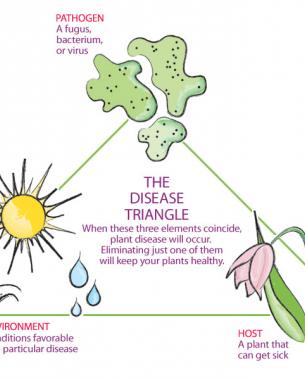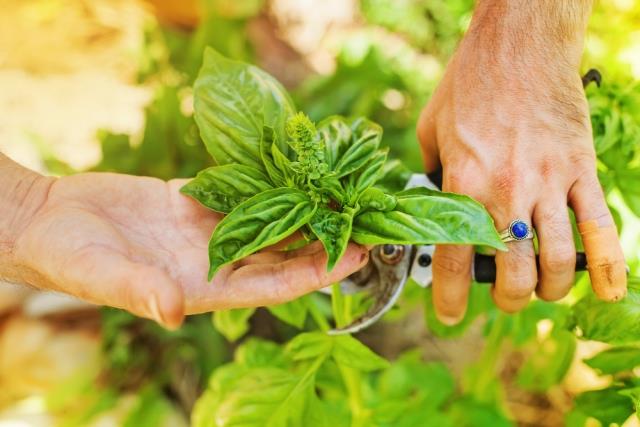How to Keep Your Garden Healthy
One of the most frustrating experiences in gardening is witnessing a beloved plant succumb to illness. Questions like “How did this happen?” and “Will it spread?” can quickly arise. The good news is that many plant diseases can be prevented by understanding the concept of the disease triangle.

The Disease Triangle Explained
Plant disease occurs when three factors converge:
- Susceptible Host: A plant that is vulnerable to a particular disease.
- Pathogen: A harmful organism like a fungus, bacterium, or virus that can infect the plant.
- Favorable Environment: Conditions that promote disease development, such as high humidity or drought stress.
If any one of these elements is missing, the disease won’t occur. Prevention, therefore, involves eliminating at least one side of the triangle. Rather than waiting for problems to arise, a proactive approach is key to maintaining a healthy garden.
Here are 7 Powerful Strategies to Keep Your Plants Disease-Free:
-
Start with Healthy Plants: The best defense against disease is to avoid introducing it in the first place. Scrutinize plants before purchasing them. Look for vibrant foliage, sturdy stems, and a healthy root system. Avoid plants with signs of disease, such as yellowing leaves, wilting, or insect damage. When examining the roots, gently remove the plant from its pot and check for firm, white or light yellow roots that fill the container. Mushy or dark roots are a warning sign.
-
Compost the Right Way: Composting is a fantastic way to create nutrient-rich soil for your garden. However, incompletely composted materials can harbor pathogens that can reintroduce disease into your garden beds. Ensure your compost reaches high temperatures for extended periods to kill harmful organisms. If unsure about the maturity of your compost pile, avoid using it as mulch around susceptible plants.
-
Manage Beneficial Insects: While some insects may damage plants cosmetically, they can also create openings for disease to enter. Furthermore, some insects act as vectors, spreading viruses from plant to plant. For instance, aphids can transmit impatiens necrotic spot virus, while leafhoppers carry aster yellows disease. Encourage beneficial insects like ladybugs and lacewings into your garden, as they can help control pest populations naturally. Additionally, consider planting companion flowers that attract beneficial insects.
-
Fertilize Wisely: Overfertilizing can damage plant roots and make them more susceptible to stress from disease. Conversely, nutrient-deficient plants may be more vulnerable to illness. A soil test conducted by your local cooperative extension office can provide valuable insights into your soil’s nutrient levels and guide you in creating a proper fertilization plan.
-
Choose Disease-Resistant Varieties: Many plant varieties boast resistance to specific diseases. Look for these designations on plant labels or consult with knowledgeable nursery staff. For example, some tomato varieties are labeled “VFN resistant,” indicating resistance to Fusarium wilt, Verticillium wilt, and nematodes. While disease resistance information is less common for flowering plants, many rose varieties are bred to resist black spots and powdery mildew.
-
Water Properly: Watering is crucial, but your chosen method can significantly impact disease prevention. Many pathogens require water to spread and reproduce. Soaker hoses or drip irrigation systems deliver water directly to the roots, minimizing moisture on leaves where fungal diseases often thrive. Avoid overhead watering, which can leave foliage wet for extended periods, promoting disease development. Water deeply and infrequently, allowing the top inch of soil to dry before watering again.
-
Provide Proper Spacing: Don’t crowd your plants! Crowded plants create a humid microclimate, perfect for diseases like powdery mildew and rust to flourish. Good air circulation is essential for healthy plants. Spacing plants according to their mature size allows for proper airflow and helps leaves dry quickly after watering or rain. Thin overcrowded plantings and prune congested areas to improve air circulation. Additionally, diseased leaves or branches should be removed promptly to prevent the spread of infection.
Conclusion: Building a Thriving Ecosystem
A healthy garden goes beyond simply keeping diseases at bay. It’s about creating a balanced ecosystem where plants can flourish naturally. Here are some additional tips to promote a thriving garden environment:
- Promote Soil Health: Conduct regular soil tests and amend your soil to improve drainage, fertility, and overall health. Organic matter like compost is a valuable soil amendment that provides nutrients and beneficial microbes.
- Embrace Organic Pest Control: Insecticides can disrupt the delicate balance of your garden ecosystem. Explore natural pest control methods like handpicking insects, using insecticidal soap sprays, or introducing beneficial insects.
- Practice Deadheading: Regularly remove spent flowers to encourage continued blooming and prevent seed production. Deadheading also helps direct the plant’s energy towards overall growth and disease resistance.

Cultivating a Disease-Resistant Garden: Beyond the Basics
The above strategies provide a strong foundation for preventing disease in your garden. However, there’s always more to learn! Here are some additional tips to consider for experienced gardeners or those seeking a more profound understanding:
Understanding Plant Susceptibility:
- Age: Young seedlings and mature plants at the end of their life cycle are often more susceptible to disease.
- Stress: Environmental stressors like drought, extreme temperatures, or nutrient deficiencies can weaken plants and make them more vulnerable to pathogens.
- Variety Selection: Some plant varieties are inherently more disease-resistant than others. Research disease resistance ratings when choosing plants for your garden.
Building a Resilient Ecosystem:
- Crop Rotation: Planting different crops in the same location each year disrupts the life cycle of soilborne pathogens that target specific plants.
- Diversity: A diverse garden with a variety of plant species creates a more balanced ecosystem that is less susceptible to widespread disease outbreaks. Include beneficial plants like marigolds or nasturtiums that can deter pests or attract beneficial insects.
- Hygiene: Clean up plant debris from your garden beds at the end of the season. This helps to remove potential overwintering sites for pathogens. Additionally, sanitize your gardening tools regularly to prevent the spread of disease between plants.
Organic Disease Management:
- Biofungicides: Products containing beneficial bacteria or fungi can be used to suppress the growth of harmful pathogens on plants.
- Neem Oil: This natural oil has insecticidal and fungicidal properties and can be a helpful tool for managing a variety of garden pests and diseases.
- Potassium Bicarbonate: A baking soda solution can be used as a fungicide to control powdery mildew and other fungal diseases.
Remember: Early detection is key! Regularly inspect your plants for signs of disease. If you identify a problem early, you can often take steps to control it before it spreads. Many organic solutions are most effective when applied preventatively throughout the growing season.!























